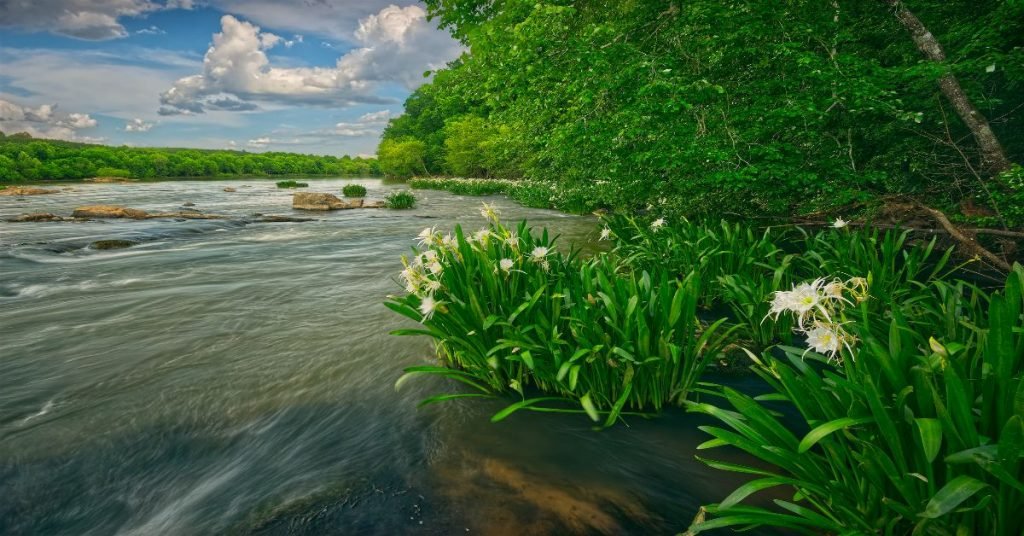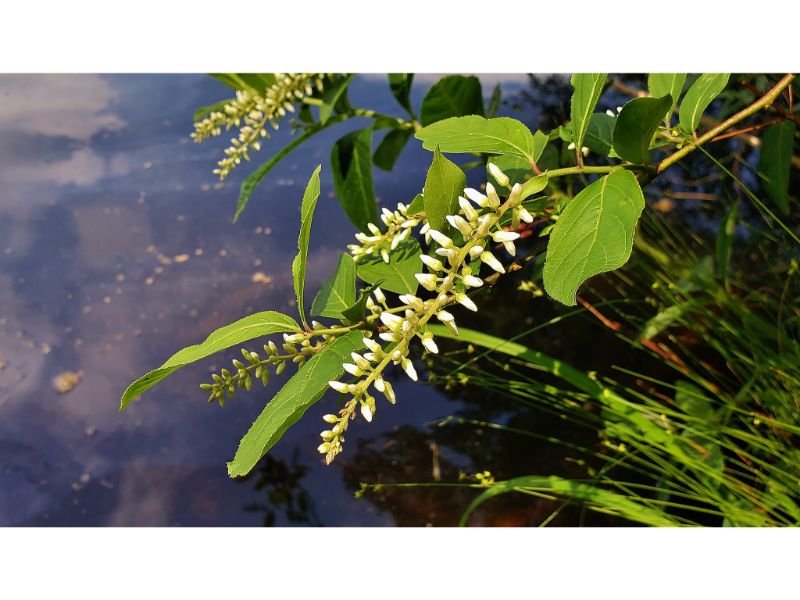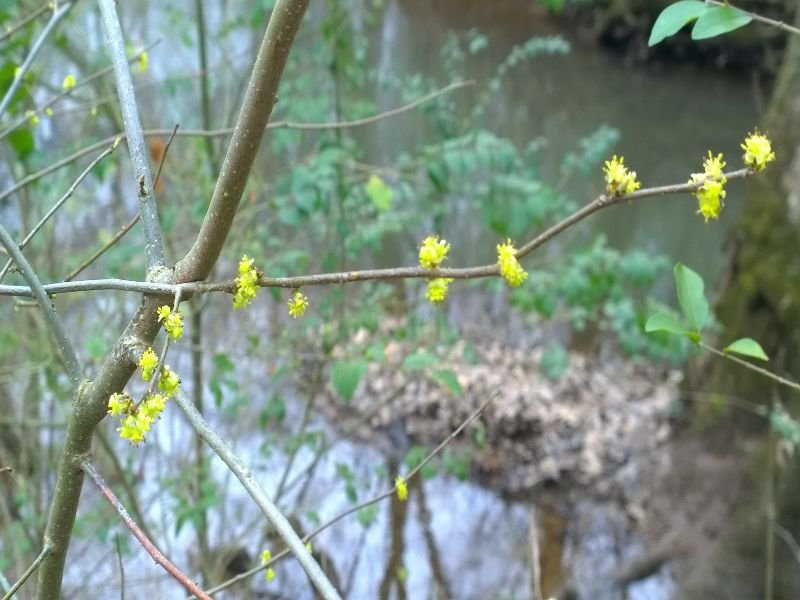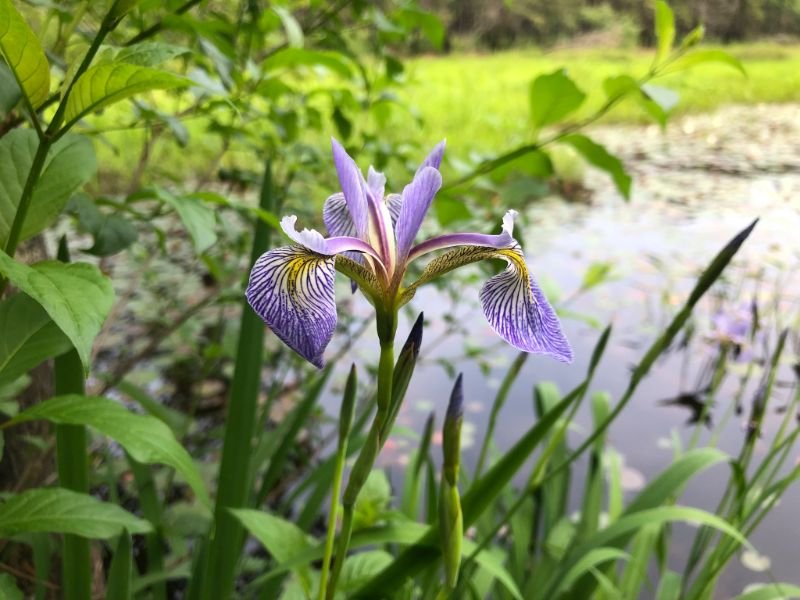With an average of minimum winter temperatures, it would likely not be difficult to find plants that thrive in Zone 7. But what if the area is blessed with moisture and wetness as constant companions? In this section, we invite you to discover a curated selection of plants and shrubs for wet areas in Zone 7. These botanical treasures have mastered the art of growing in such conditions, making it possible to transform the area into a green oasis. Let’s dig in!

Table of Contents
Small Shrubs for Wet Areas Zone 7
Mountain Witch Alder (Fothergilla latifolia)

Plant Size: 3 to 6 feet tall
Resilient To: Deer, wet soil, somewhat cold hardy
Garden Theme(s): Woodland, native garden, pollinator garden
Mountain witch alder is a native of the Appalachian Mountains, best known for its witch hazel-like blooms. They produce pleasant-smelling flowers which can be described as a combination of sweet honey and spice, thus pollinators are crazy over this plant. In the wild, these shrubs for wet areas in zone 7 have adapted to periodic flooding.
Virginia Sweetspire (Itea virginica)

Plant Size: 3 to 4 feet tall
Resilient To: Shade, deer
Garden Theme(s): Water garden, cottage garden
Virginia sweetspire got its name due to the sweet fragrance emitted by its flowers. These shrubs for wet areas zone 7 stuns with small and white blooms that are arranged in tassel-like clusters. Adaptable to a wide range of soil types, these beauties prefer moist soil with excellent drainage.
White Meadowsweet (Spiraea alba)

Plant Size: 2 to 4 feet tall
Resilient To: Wet soil, shade
Garden Theme(s): Wildlife garden, rain garden
Although not labeled as edible plants, white meadowsweet was commonly used by Native American tribes for medicinal purposes. The shrubs for wet areas in zone 7 feature groups of tiny white blooms that form dense, conical-shaped inflorescences. In their natural habitat, you can find white meadowsweet growing rapidly in marshes, damp meadows, and streambanks.
Moist-loving Large Shrub of Zone 7
Northern Spicebush (Lindera benzoin)

Plant Size: 6 to 8 feet tall
Resilient To: Moisture, wet soil
Garden Theme(s): Naturalized garden, woodland garden
Did you know that the northern spicebush has a separate female and male plant? Yes, that’s true! These large, wet-soil-loving shrubs are dioecious and only female plants produce the attractive red berry-like fruits. This plant tolerates a wide range of humidity levels and is also suitable for any type of soil.
Silky Dogwood (Cornus amomum)

Plant Size: 5 to 10 feet tall
Resilient To: Soil erosion, shade
Garden Theme(s): Wetland, wildlife garden
When it comes to selecting shrubs for wet areas Zone 7, silky dogwood stands out as an excellent choice. Also known as swamp dogwood and ‘kinnikinnik’, silky dogwood is favored by plant lovers mostly for its smooth and velvety foliage. Native to wetland areas, they have adapted to slightly acidic soil with a pH of 5.5 to 6.5. However, these plants are not very forgiving about hot weather and prefer to be under the shade if they thrive in hotter climates.
Smooth Hydrangea (Hydrangea arborescens)

Plant Size: 4 to 5 feet
Resilient To: Cold, heat
Garden Theme(s): Shade garden, cottage garden, mixed border
Ah, the classic hydrangea. Even if you’re new to the world of gardening, perhaps, you might have heard about these flowering shrubs for wet areas in Zone 7. All thanks to their popularity as chameleon plants that change their blooming color according to their pH level. Unlike any other hydrangea species, smooth hydrangea produces flowers on wood, which makes the plant the ability to bloom reliably each year.
More read:
- The Best Indoor Plant Grow Lights for Thriving Houseplants
- Gardening Books: Essential Reads for Green Thumbs
- DIY Garden Projects: Creative Planting Ideas
- The Ultimate Guide to Organic Fertilizers for Healthy Plant Growth
- Must-Have Garden Insecticide for Pest Control Solutions
Flowering Plants for Wet Areas Zone 7
Northern Blue Flag (Iris versicolor)

Plant Size: 2 to 3 feet
Resilient To: Wet soil, cold
Garden Theme(s): Water garden, rain garden, wildlife garden
Grow in deep violet-blue, lighter shades of purple or blue, and sometimes white, the northern blue flag iris is the ultimate flowering plant for wet areas of zones 7 for various reasons. First, they can thrive on the edges of ponds, streams, marshes, or even wet meadows. Next, they tolerate high moisture levels and can be grown under both full sun or partial shade without worry–although, for optimal blooming, it’s best to grow them under bright, direct light.
Water Canna (Canna glauca)

Plant Size: 3 to 5 feet
Resilient To: Heat, deer, wet soil
Garden Theme(s): Water garden, tropical garden, wetland garden
A native to tropical and subtropical regions, water canna is prized for its vibrant blooms that grow in shades of orange, yellow, or red. They prefer to be kept in constant wet soil conditions, making them highly suitable flowering plants for wet areas in zone 7 as long as the humidity level is above average.
Spider Lily (Hymenocallis)

Plant Size: 1 to 3 feet
Resilient To: Deer, heat, moisture
Garden Theme(s): Water garden, cottage garden, container garden
To all plant enthusiasts who are living in Zone 7 with constant wet soil but struggle with limited gardening space, spider lily offers a captivating solution. With its manageable size, the main charm of spider lilies comes from their blooms, which typically are large, trumpet-shaped, with unique petals that radiate outwards, resembling a spider’s leg.
Ornamental Grasses for Wet Areas of Zone 7
Northern Sea Oats (Chasmanthium latifolium)

Plant Size: 2 to 4 feet
Resilient To: Deer, shade
Garden Theme(s): Woodland garden, prairie garden, wetland garden
While shrubs for wet areas in Zone 7 can add more grace and movement, ornamental grasses like northern sea oats also play an equally important role in creating an eye-catching landscape. Beloved for their seed heads, which resemble oats, these decorative plants are suitable for constantly wet areas due to their high tolerance to moisture. The deep root system of northern sea oats also helps to stabilize the soil and prevent erosion!
Japanese Rush (Acorus gramineus)

Plant Size: 1 to 1.5 feet
Resilient To: Shade, wet soil
Garden Theme(s): Asian garden, water garden, rock garden
Being blessed with a grass-like appearance, Japanese rush is not a true grass (Poaceae) as they’re coming from the Acoraceae family, which is a group of wetland plants. The plant does not produce showy and remarkable blooms but surely will add a lush and vibrant touch to your garden!
Reed Canary Grass (Phalaris arundinacea)

Plant Size: 3 to 6 feet
Resilient To: Wet soil
Garden Theme(s): Wetland gardens, meadow gardens, prairie gardens
Notable for its seed heads that are just a copy-paste of canary bird feathers, reed canary grass is a match for those who love wet soil-loving plants with rapid growth. In general, this plant has no special cultivation needs, as it’s adaptable to a wide range of soil types with a pH ranging anywhere from 5.0 to 8.0 (acidic to alkaline).
How Much Water Do Plants for Wet Areas Zone 7 Actually Need?
We all might think that perhaps, plants and shrubs for wet areas in zone 7 require less watering in comparison to any other plants. Overall, they’re living in constant moisture, so why do these plants need any more water? Well, this is not a completely correct answer.
The exact water needs can vary depending on the specific plant species and the prevailing weather conditions. As a general rule of thumb, keeping the soil not waterlogged is still important, especially throughout the growing season. Regular deep watering, on the other side, is still necessary for dry periods. Proper drainage is also no less essential to promote healthy plant growth and prevent problems such as root rot.
Water-loving Zone 7 Plants In A Nutshell
As you can see, living in Zone 7 with damp surroundings doesn’t have to be a thorn in the side. Flowering plants and shrubs for wet areas in zone 7, from the classic northern blue flag to the massive silky dogwood, offer a resilient solution for those seeking to embrace the challenges of these constant wet areas.

New author in the hood. Loves gardening and flowers are my spirit animals (yes I know they are not animals but I insist). I will be covering most of the flowers’ topics here and occasionally random though as well.






